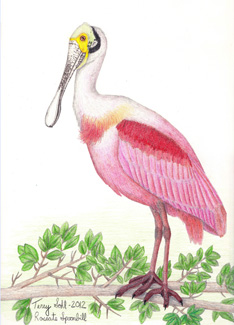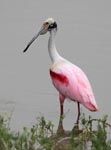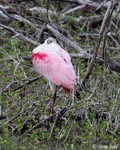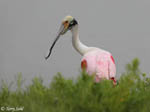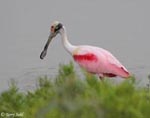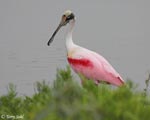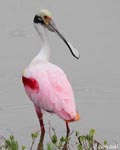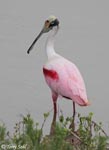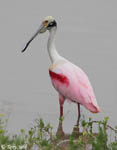| Length: 32 inches | Wingspan: 48-52 inches | Seasonality: Non-resident in South Dakota |
| ID Keys: Pink body with white neck, distinctive spoon-shaped bill. | ||
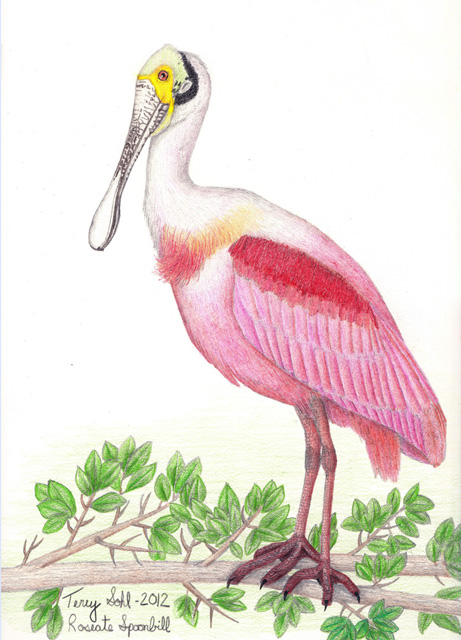 Roseate
Spoonbills are very distinctive birds from the southeastern United States, a
species that was once much more common before the feather trade devastated
the species in the 1800s. While numbers are recovering in the U.S.,
the species has a wide geographic distribution, with higher populations
found throughout Latin America. When seen from a moderate distance,
the beautiful pink plumage and general outline provide the impression of a
stunningly beautiful bird, an impression that is dampened somewhat upon a
closer view by the somewhat less attractive head and face.
Roseate
Spoonbills are very distinctive birds from the southeastern United States, a
species that was once much more common before the feather trade devastated
the species in the 1800s. While numbers are recovering in the U.S.,
the species has a wide geographic distribution, with higher populations
found throughout Latin America. When seen from a moderate distance,
the beautiful pink plumage and general outline provide the impression of a
stunningly beautiful bird, an impression that is dampened somewhat upon a
closer view by the somewhat less attractive head and face.
Habitat: Roseate Spoonbills can be found foraging in both freshwater and saltwater, typically relatively close to the ocean int he U.S. During the summer breeding season in the U.S., nesting colonies are found in mangrove swamps in Florida, and in other forested wetlands elsewhere along the Gulf Coast.
Diet: Feeds on a variety of aquatic animals, including small fish, crayfish, shrimp, crabs, large aquatic insects, leeches, slugs, frogs, and salamanders They will also consume the tubers and new shoots of some aquatic plants.
Behavior: Uses it's unique spoon-shaped bill to forage by wading in shallow water, and swinging its bill from side to side until prey is detected.
Nesting: The nest of a Roseate Spoonbill is a large platform of sticks and branches, depressed in the middle and lined with leaves and other smaller pieces of vegetation. Both parents incubate the eggs, and both parents help to raise the young.
Song: Has a low, consistent grunting.
Migration: Considered a permanent resident throughout most of their range, but many U.S. birds are migratory, moving to Mexico or the Caribbean for the winter. Young first-year birds may disperse widely after fledging, and make up the majority of Roseate Spoonbill vagrants that have been seen in far-flung, inland locations (see map below).
Interactive eBird Map: Click here to access an interactive eBird map of Roseate Spoonbill sightings
Similar Species: Distinctive if seen well. From a distance, the American Flamingo can look similar, with pink plumage that is similar in hue, but the two species are very distinct if seen well.
Conservation Status: Listed as a species of "Least Concern" by the IUCN. Still much less common in the U.S. portion of its range than it was historically, as the species was heavily affected by those "harvesting" the birds for their feathers in the 1800s. Populations globally are stable, however.
Further Information: 1) Cornell's All About Birds - Roseate Spoonbill
2) Audubon Guide - Roseate Spoonbill
3) Texas Parks & Wildlife - Roseate Spoonbill
Image Information: Colored pencil drawing by Terry Sohl
| Click below for a higher-resolution map |
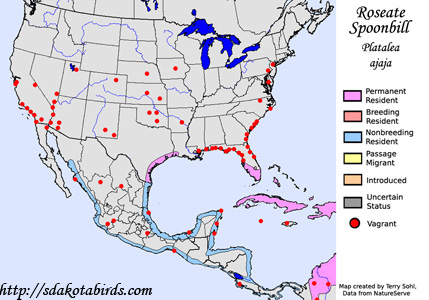 |
| South Dakota Status: Non-resident in South Dakota |
Additional Roseate Spoonbill Images
Click for a higher-resolution version of these photos
